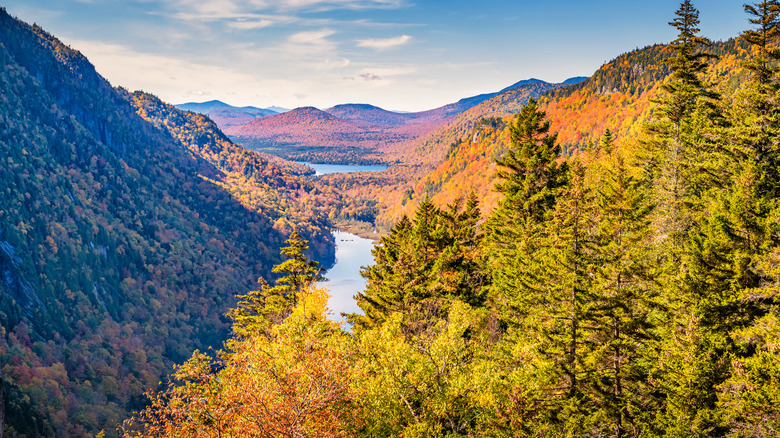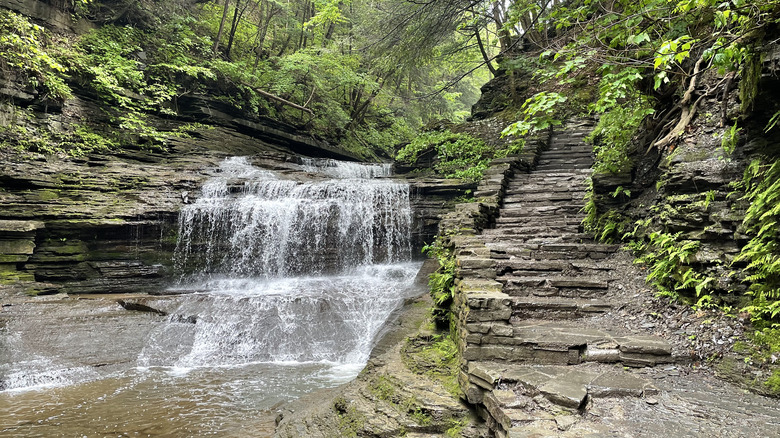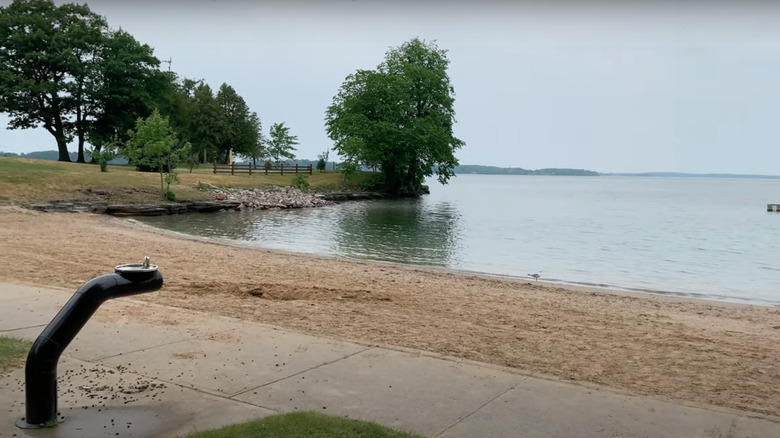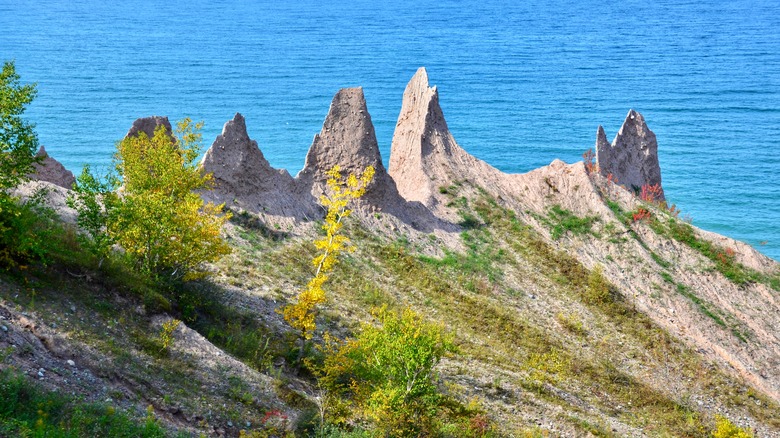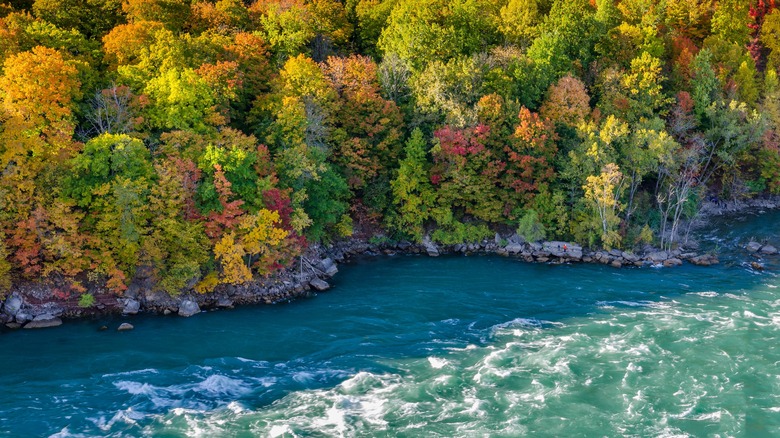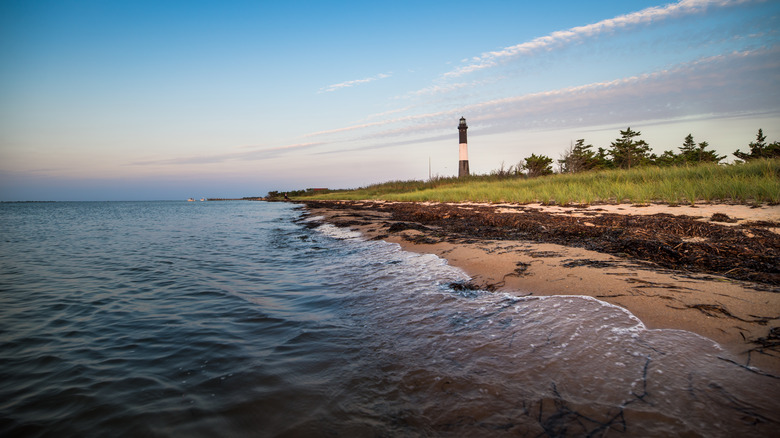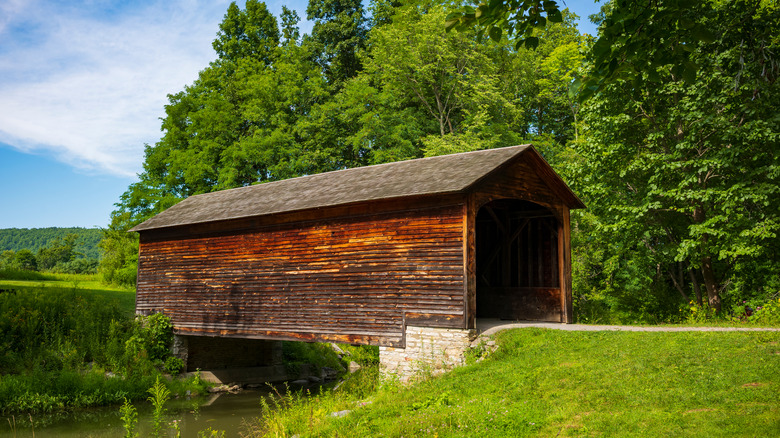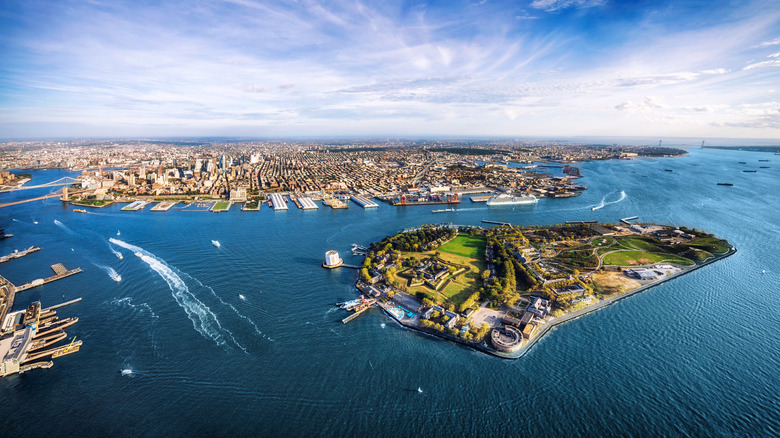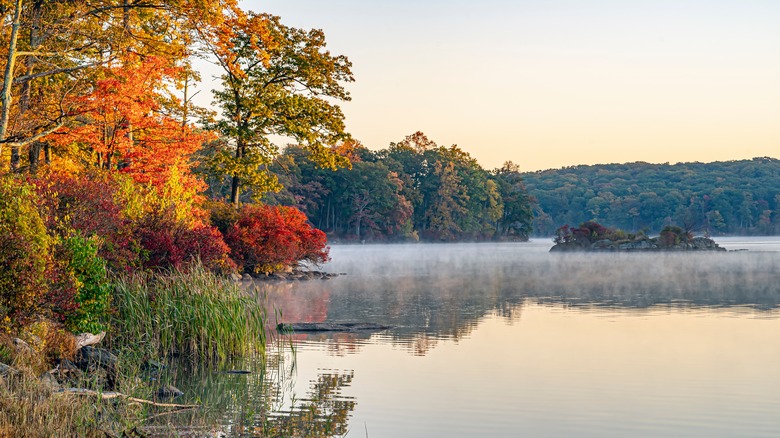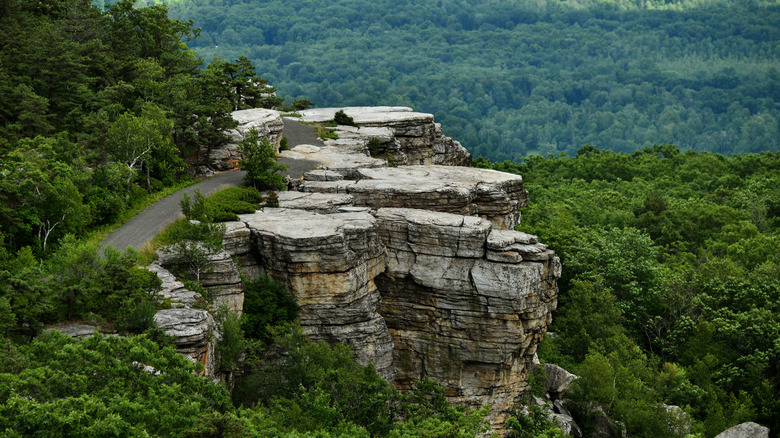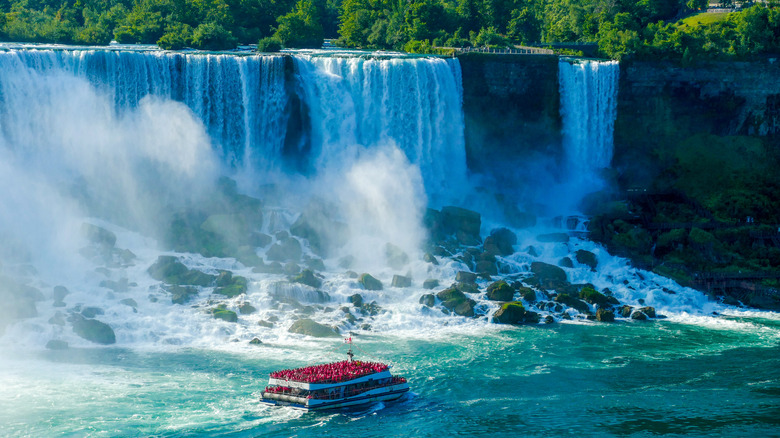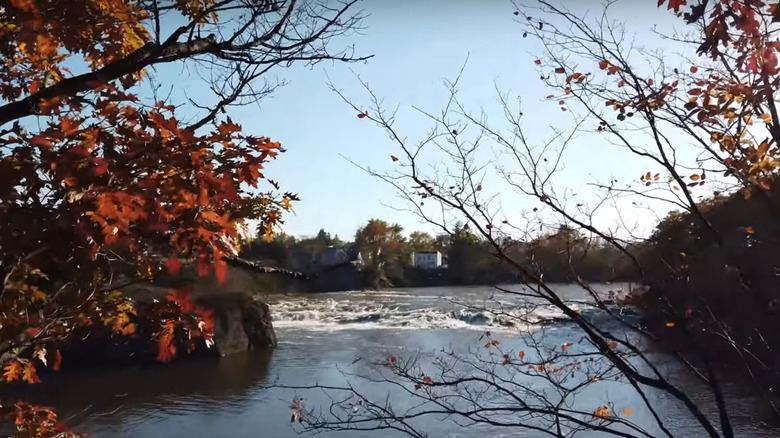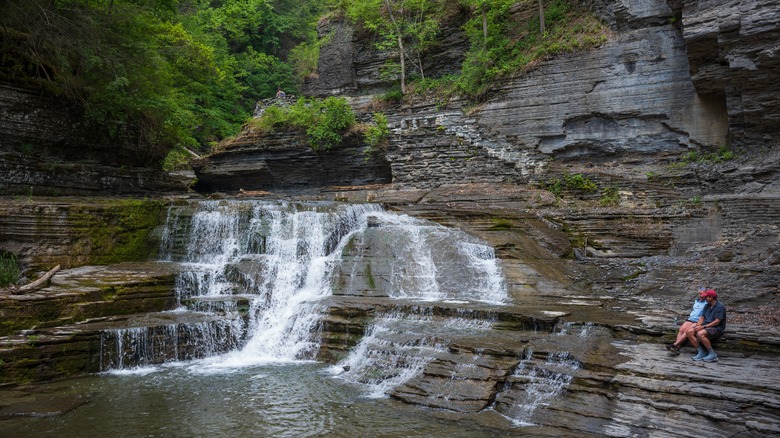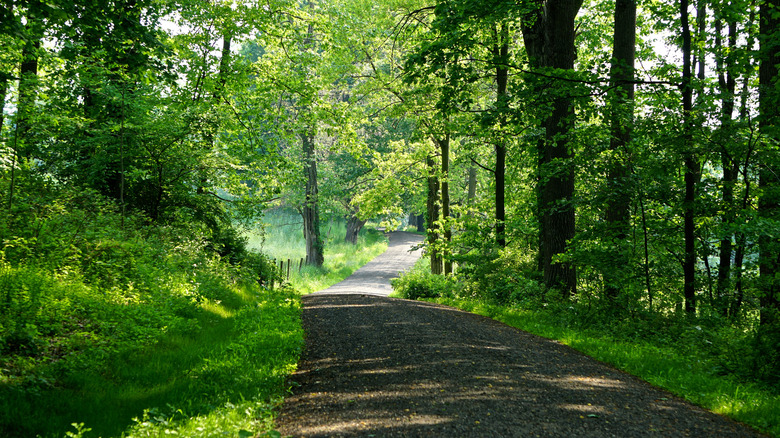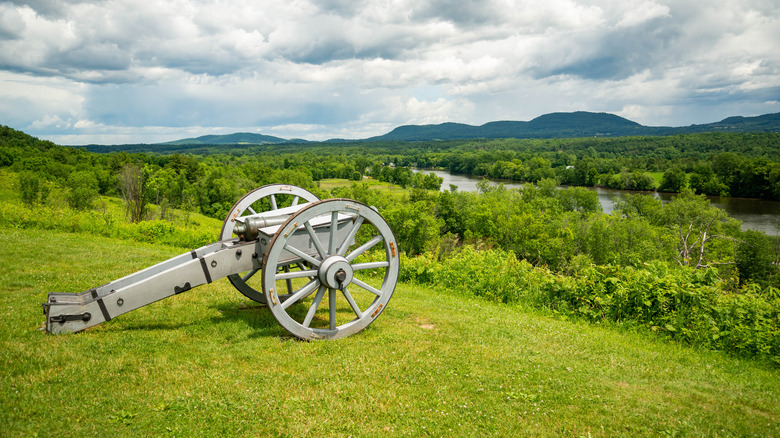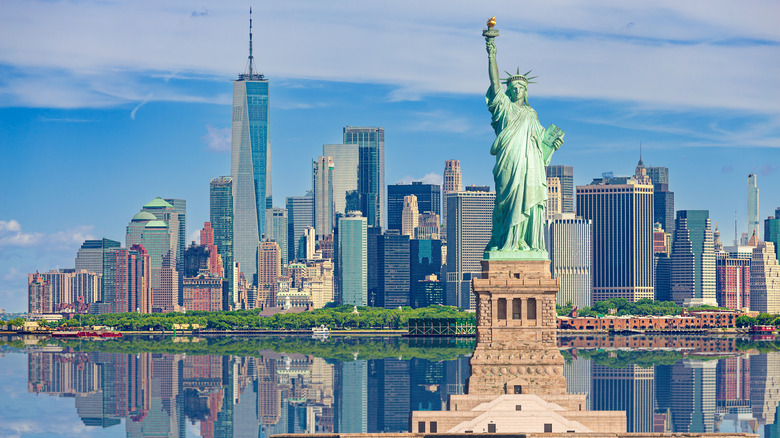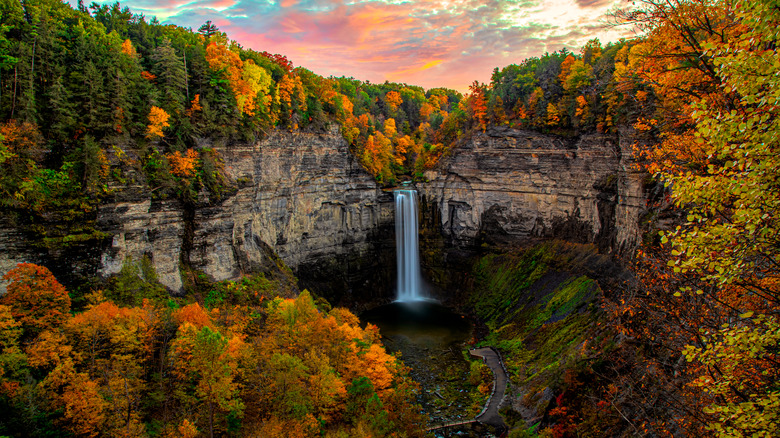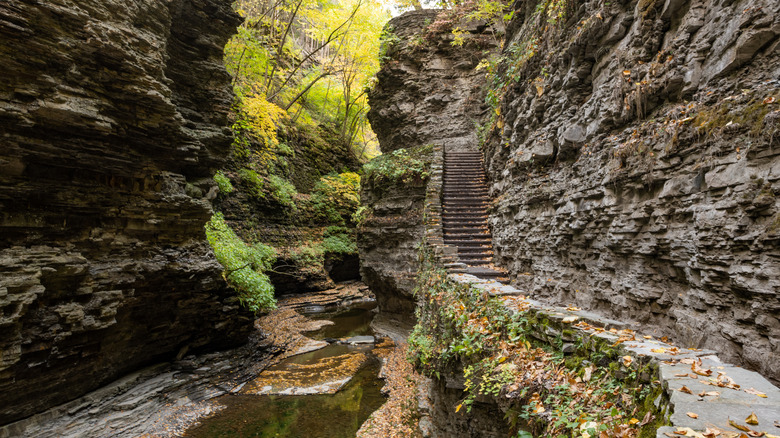The Most Breathtaking National And State Parks To Visit In New York
A state with one of the highest populations in the country, New York is also home to the nation's most populous city, New York City. It's a place of great diversity, not only in terms of its varied cultures, but also naturally. New York is where long strips of sandy shore, rugged mountains, twisting canyons, rolling plains, and giant lakes all come together to call the Empire State home. Vacationers could spend weeks exploring New York's natural charms, from the eastern tip of Long Island as it reaches out to the Atlantic, all the way up to the border of the Canadian provinces of Ontario and Quebec.
With so much choice, planning a trip to New York can be daunting. Below, we present a sampling of some of the most inspiring and beautiful national and state parks in New York. It's important to note that the largest park in the state, Adirondack Park, doesn't appear on this list; neither a national park, nor a state park, it is a National Historic Landmark (and gorgeous to boot). But fret not, as the destinations below clearly illustrate, there is plenty more to see in the Empire State.
Buttermilk Falls State Park
In a part of central New York known as the Finger Lakes, named for the long, skinny bodies of water that splay across the land like slender, elegant fingers, this park is also a huge draw for water admirers. More precisely, the waterfalls here are a sumptuous sight, formed by the flow of Buttermilk Creek making its way along the valley floor as it pushes forward to Cayuga Lake.
The cascades appear in various guises, gently dropping down terraced layers of rock, cutting through other parts of rock to create curving gorges, and sliding down slopes to create frothing torrents. Some of the pools that the falls empty into are perfect for swimming — a cooling tub of natural water that is a glorious recipe for relaxation on a hot summer's day. Elsewhere, visitors can find a number of trails that slice through the woods or along the edges of the gorge, and even see an area of wetlands.
Cedar Island State Park
Cedar Islands, set in the St. Lawrence River close to the border with Canada, is a real escape. It is one of a vast number of small isles in the waters of Chippewa Bay, and during fall, the trees here light up in a blaze of warming hues. The park takes up the northern half of the island, and is a paradise of solitude, with docks that allow for easy boating, many spots to take in some fishing, and walks in the woods.
A number of campgrounds in the park allow visitors to enjoy the serene surroundings for extended periods, and the views of the broad river are a great morning wake-up call. While in the area, visitors should be sure to make a trip to the nearby Singer Castle, a giant granite castle situated on the nearby Dark Island, and that used to belong to the head of Singer, the company that makes sewing machines.
Chimney Bluffs State Park
Located east of Rochester, on the shores of Lake Ontario, Chimney Bluffs State Park has a name that gives visitors a hint of what to expect. While the opportunities to look over the never-ending expanse of the lake are reason enough to visit, the views of the jagged, pointy rock formations along its coastline make this a truly hypnotic spectacle. Rising like church spires, or the craggy teeth of a prehistoric beast, this park is a realm of sculptural beauty, rocks eroded and shaped by the elements, extending out along bluffs that meet the water's edge.
The contrast between the sharp, elevated features and the flat, blue water below is a scintillating combination — and one that almost defies belief. The bluffs themselves are accessible via trails from the parking area. For a truly unforgettable visual feast, try to visit them at sunset from a vantage point that looks west to see the fading sun cast a warming glow on their haunting contours.
Devil's Hole State Park
An easy trip from Niagara Falls — it sits a short distance to the north of the cascades — Devil's Hole State Park should be visited for its name alone. While the mammoth waterfall at Niagara Falls might get the lion's share of tourists in this region, the churning, frothing waters of the Devil's Hole Rapids, for which the park is named, are a sight not to be missed. Loaded with immense power, like a raging torrent that can consume everything in its path, the rapids are heavy and dangerous, best viewed from a distance, or on one of the jet-boat tours that do the rounds.
Getting to a viewing spot is easy enough without the need to book a separate excursion, as a stairway made of stone descends to a trail that places visitors in prime viewing position of the rapids. Look across to marvel at the roiling waters and giant rocks along the river.
Fire Island National Seashore
A national park that sits just off Long Island, Fire Island National Seashore is home to 26 miles of shore — and some of the finest beaches anywhere along the U.S. East Coast. For residents of New York City, Fire Island is a familiar, beloved summer destination, just an hour away from the Big Apple, and beautifully natural. A visit here can include a stop at the lighthouse, walks through old forests, and strolls around the homes of people that played a key role in American history, like William Floyd, one of the signers of the Declaration of Independence.
Of course, there is always the beach. Since this national park can only be reached by boat, with no paved roads anywhere along it, waterfront areas aren't blighted by the disheartening beach traffic that many other beaches in and around Long Island might suffer. Fire Island is also known as a hugely welcoming destination for the LGBTQ+ community, even spawning a film called "Fire Island" that premiered in 2022.
Glimmerglass State Park
Baseball fans will know all about the small town of Cooperstown, home to the Baseball Hall of Fame & Museum, while opera buffs might know it for the annual Glimmerglass Festival. But a short distance north from Cooperstown, which sits at the southern point of Otsego Lake, Glimmerglass State Park is a haven of woods, hills, trails, and water. It also sits on Otsego Lake, a body of water that was the inspiration for the name Glimmerglass, immortalized in the novels by James Fenimore Cooper that made up the Leatherstocking Tales.
It's a pretty part of New York — rural, yet not too remote, with rolling woods rising up from the lake and paths through the trees that allow hikers to get fine views of the water. The park is also where you can find the Hyde Hall Covered Bridge, built in 1825 and believed to be the oldest standing covered bridge in the country.
Governors Island National Monument
Sitting just south of the soaring skyline of Manhattan's Financial District, where the East River and Hudson River meet, Governors Island National Monument is a living vestige of the city's history from two centuries ago. The island was a military stronghold, with the circular Castle Williams and the angular Fort Jay playing important roles in the defense of the city from possible naval attacks, part of a larger network up and down the coast to protect the country's marine borders.
Since then, the island has served as an army headquarters and even a Coast Guard base. Nowadays, visitors are likely to come for the Civil War era re-enactments, to lay on large grassy lawns, or to cycle around the island's winding paths. A trip onto the island, only accessible by ferry, promises a fascinating look at the past, as well as striking views of the present — the towers of Manhattan are clearly visible in the near distance.
Harriman State Park
Where to start with this mammoth park by the Hudson Valley and northwest of the Big Apple? There is almost too much to do at Harriman State Park, a fact that is borne out by the dizzying statistics on the place — 200 miles of trails to hike, more than 30 lakes and reservoirs, a pair of beaches so visitors can get into the water, camping areas, and scores of streams where adventurers can enjoy the babbling sounds of water while surrounded by trees.
The park really is a gem, popular with cyclists from New York City who get here early to climb the hills and winding routes within its boundaries, as well as city hikers pining for a dose of wilderness. And it is wild, with bears living here in healthy numbers — this explains why the state's park authorities place warnings on its website and advise campers what to do if approached by an ursine caller.
Minnewaska State Park Preserve
A couple of hours drive north of New York City, Minnewaska State Park Preserve is a delight for the active-minded, as well as anyone in search of some finely weathered mountain territory. The park sits along the ridge of the Shawangunk Mountains, a range extolled by climbers in the area, and its elevation allows for expansive views of the surrounding natural canvas. And those views are quite breathtaking, sometimes on bluffs that survey the tops of trees or along ridge lines that rise above lakes.
There are many waterfalls, cliffs that allow visitors to feel like they are on top of the world, and forests spliced by hiking trails — with 50 miles of paths that can be hiked or biked. There are also places to swim, climb, and even scuba dive. For those who like their adventure light, a trip here is immensely satisfying; you can simply sit by a waterfall that drops over a wall of rock into a crystal-clear pool to witness nature distilled down to its purest best.
Niagara Falls State Park
Does this part of North America need any introduction? One of the greatest tourist attractions in the world, Niagara Falls might not get the same praise that the Canadian side gets (half of the Falls is in Canada, and the other half resides in the U.S.), but they are still a sight to behold. Of all the state parks in the country, this one is the oldest, and, of course, hugely popular, with millions of tourists arriving each year.
The thundering rapids are the star attraction, with more than 3,000 tons of water dropping over the two sets of falls every second. Visitors can get really close to that unbridled power by taking stairs close to the waterfalls on a section known as the Cave of the Winds — a wild and wet experience that you'll never forget— as well as the famous Maid of the Mist boat ride. There is also fabulous hiking in the park, including walks along the Niagara Gorge, with walks all starting at one main trailhead to make starting your hike even easier.
Peebles Island State Park
A short drive north of Albany, the capital of New York State, this slash of greenery sits surrounded by water, where the Mohawk River and Hudson River meet. There are lots of walking trails that criss-cross Peebles Island State Park. When venturing inside the woods, visitors might feel like they are miles from civilization. It's an extremely peaceful place, with some paths running along the river's edge.
For such a small destination, there is surprising variety. Walks can go through broad fields, dive into dense forests, laze past bubbling river rapids, and rumble along elevated sections that tower above cliffs. There is plenty of wildlife, such as deer, hawks, and skunks. The island is one of many at the confluence of these rivers, and even though urban areas lie close by, there really is a sense of total escape, which is the whole point of visiting a park, isn't it?
Robert H. Treman State Park
Located in the Finger Lakes region of the state, and named after a corporate scion who grew up in this neck of the woods, Robert H. Treman State Park has spellbinding, curving rock faces that will entrance any visitor. Trails meander along the sheer rock faces, tracing the contours of the gorge as they pass a number of waterfalls. The tallest of the cascades is the sinister-sounding Lucifer Falls, an impressive 115-foot drop that is not only a striking natural phenomenon in itself, but also a spot that affords fine vistas down along the body of the gorge.
There are a number of trails around the park that let visitors explore the main towering gorge, called Enfield Glen, and even a spacious swimming area that sits below a cute, frothing waterfall. On a still, humid summer's day, after hours of walking around the park, there is nowhere finer to cool yourself.
Rockefeller State Park Preserve
Yes, Rockefeller State Park Preserve, which can be reached from the heart of New York City in less than an hour, does refer to the powerful American family. This patch of land was once part of the Rockefeller empire, an expanse near the Hudson River, formerly known as the Pocantico Hills and Rockwood Halls estates. Now, more than 1,700 acres form this park, where the terrain ranges from hills populated with dense woods, to picturesque valleys and tranquil country fields. The pathways here were former carriage roads made of crushed stones to form a network of almost 50 miles that are a walker's dream.
Wandering along the trails, visitors might encounter a placid lake, the gentle flow of a river, bridges made both of stone and wood, cliffs, and of course, plenty of trees, with oaks, poplar, and beech among them. Birders also prize this destination for the rich avian life — more than 200 species of birds have been spotted here.
Saratoga National Historic Park
A national park with great historical significance, this is where American and British troops fought in years gone by. It was in late 1777, during the Revolutionary War, that a key battle took place in these fields, with the Americans vanquishing the British army and injecting much needed morale into the war effort. Various pieces of Saratoga National Historic Park recall that era, including the towering Saratoga Monument, made of bronze and stone, and rising more than 150 feet into the air, built to commemorate the British surrender and American victory.
Visitors can also walk along the Wilkinson Trail, a 4-mile loop that courses through part of the original battlefield, as well as pastoral fields, woods, and hills. Today, travelers might find it hard to conjure up images of young men fighting ardently on this tranquil spot, but this part of the state is a priceless part of American history.
Statue of Liberty National Monument
If any single image is representative of the United States, it would be the Statue of Liberty, an icon that most visitors to New York yearn to see. Lady Liberty stands proud on the self-contained, 12-acre Liberty Island, south of the island of Manhattan in New York Harbor. The towering sculpture was, as the familiar story goes, gifted to America by France in the 1880s before officially being commemorated in its present location in 1886.
Beyond being a landmark beyond compare, the giant figure is certainly an impressive piece of work. It stands more than 150 feet tall, and, at one point, was the tallest man-made structure in the world. During high winds, the statue even sways, with the torch above moving up to 5 inches back and forth. The interior of the statue is a real feat of engineering, with soaring columns made of iron providing the foundation that secures an inner frame and 300 sheets of copper laid on top. Climbing to the crown requires ascending a lot of steps, but the views are worth it.
Taughannock Falls State Park
This Finger Lakes' park is a three-hour drive from Niagara Falls. While the former might not be as famous as the latter, it's worth visiting Taughannock Falls State Park for its ravishing cascade — one that will take the breath away of any onlooker. The waterfall, for which the park is named, is actually taller than Niagara Falls, dropping more than 200 feet. This natural wonder is notable in another aspect — of all the single-drop waterfalls that sit east of the Rocky Mountains, Taughannock Falls is the tallest.
While the volume of water pales in significance compared to the legendary Niagara Falls, the sight is still sublime. Coupled with the hiking trails that wind around the gorge's rim, this really is a beautiful part of the state. Though swimming in the pool underneath the falls is not permitted, a beach on nearby Cayuga Lake allows water enthusiasts to get fully wet.
Watkins Glen State Park
At times, when ambling around this park also in the Finger Lakes, visitors might find themselves sighing in complete contentment — such is the all-consuming beauty of this natural gem. The twisting canyons and gorges at Watkins Glen State Park can feel otherworldly at times. There are terraced layers of rock sometimes topped with moss, other times moistened by small streams of water falling from above, with the main glen waterway continuing to cut its way through the rock.
The water runs along 2 miles of gorge, gradually dropping 400 feet in the process. There are 200-foot cliffs that help create 19 waterfalls as the water travels along its journey. Trails hover over falls, or sometimes pass below them, and, on one occasion, even pass through an area where the spray of a cascade provides some welcome relief from the heat. Since the gap between the banks of the river is small and the gorge is compact, the walk is often shaded, even on a sunny day.
